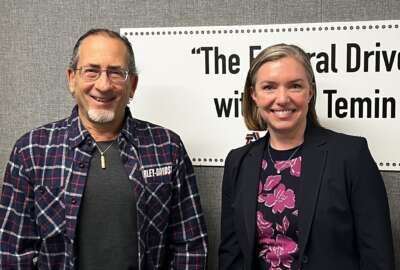VA’s Blue Button now at 1 million users, aims at 100 million soon
Veterans Affairs PHR effort has already gone far beyond VA. After reaching 1 million users, originators of the project have set their sights on 100 million.
wfedstaff | April 17, 2015 4:09 pm
Two years ago, the Department of Veterans Affairs’ Blue Button project started with the idea that VA could improve veterans’ health outcomes by giving them something they’d been clamoring for: easy access to their own health records that had theretofore been locked up in VA’s data systems and visible only to health care providers.
But VA says more than 1 million users have now signed up for Blue Button, which now extends far beyond the walls of VA. The Defense Department and the Centers for Medicare and Medicaid Services have adopted VA’s personal health record (PHR) framework, as have several of the large insurance companies that serve civilian federal employees.
Last month, in its first round of Presidential Innovation Fellowships, the Obama Administration brought aboard three technologists who want to help nationalize Blue Button, one of only five projects the White House settled on.
Peter Levin, VA’s chief technology officer, said the nation as a whole has been looking for a robust PHR system for a long time. But he contends VA was a logical place to start the effort.
“We have an especially vibrant and articulate stakeholder community,” Levin said in an interview with Federal News Radio. “If you’ve ever engaged a veteran on veterans’ issues, you know these are folks who have strongly-held opinions that they’re not afraid to share. They’ve been agitating for this kind of access to this kind of health data for a very long time.”
‘No nuclear physics here.’
The initial impediments, Levin said, weren’t technological ones.
“There was no nuclear physics here. It’s not that hard to strip out all of the things on the back end that make a bold font and a blue background and put raw health data out.” he said. “Once we got the directive from the Secretary of Veterans Affairs himself, from a technical perspective it was really simple to implement.” 
“It was a big step in terms of attitude,” he said. “Providers now understand that it’s OK to make that data available, and patients now understand it’s OK to get that data. Both parties now understand in that conversation that they should be talking.”
Within VA, Levin said, providers have mostly embraced the idea. But holdouts do exist.
“You’re going to find some providers in our enormous national system that haven’t gotten the memo yet,” he said. “They’re going to say, ‘Why would you want that data? All a patient’s going to do is go to the Internet and start asking questions that make them more anxious and use more of my time.’ Those folks exist. But they’re in the minority.”
Between the patients served by VA, DoD, CMS and the private insurers that have created portable, interoperable health records under the Blue Button framework, Levin figures that 100 million Americans already have access to their own health records, even if they don’t know it.
Blue Button for America
A new phase of the program, called Blue Button for America, aims to spread the idea further, which is where the White House’s technology fellows come in.
The goal, Levin said, is to let any citizen access his or her health information. That citizen would be able to access that information regardless of which doctor created it, move it from insurer to insurer and be confident that the data was secure.
“By definition, Blue Button means it’s portable,” Levin said. “But we need to make sure that the patients, the providers and the payers know that they should all be providing information, asking for information and they should be sharing all of the information between them.”
Levin said VA wants to get Blue Button to the point that it’s so platform-agnostic that health care records can move across health care providers as easily as phone calls move across area codes. The idea is to create a lightweight, easy-to-operate data standard that can be implemented by any healthcare provider or insurance company, with health data tagged in a way that everyone can agree on.
VA and its partners, including its new presidential fellows, are still working on the question of where that data could reside so that it’s accessible to providers, patients and providers, but still secure against cyber intrusions or government overreach.
“It may be that one repository will eventually sort of emerge as market forces eventually decide that it’s efficient, that it’s private, that it’s safe, that people are confident that we’ve solved the cybersecurity issues. But it certainly, by no means, is going to involve the federal government,” Levin said. “The point is to make sure that you, as a patient, have control over that data and where it’s going in a very, very granular way.”
RELATED STORIES:
White House selects innovation fellows for five federal projects
Federal health plans to offer Blue Button digital health-record access
Agencies’ health IT success becomes model for nation
Copyright © 2025 Federal News Network. All rights reserved. This website is not intended for users located within the European Economic Area.
Jared Serbu is deputy editor of Federal News Network and reports on the Defense Department’s contracting, legislative, workforce and IT issues.
Follow @jserbuWFED






